Cookware-Safely Clean Your Cast-Iron Pan With This Common Pantry Staple
Safely Clean Your Cast-Iron Pan With This Common Pantry Staple
Soap will strip your skillet of flavor and nonstick qualities. Here's how to safely clean a scorched pan with something you already have on hand.
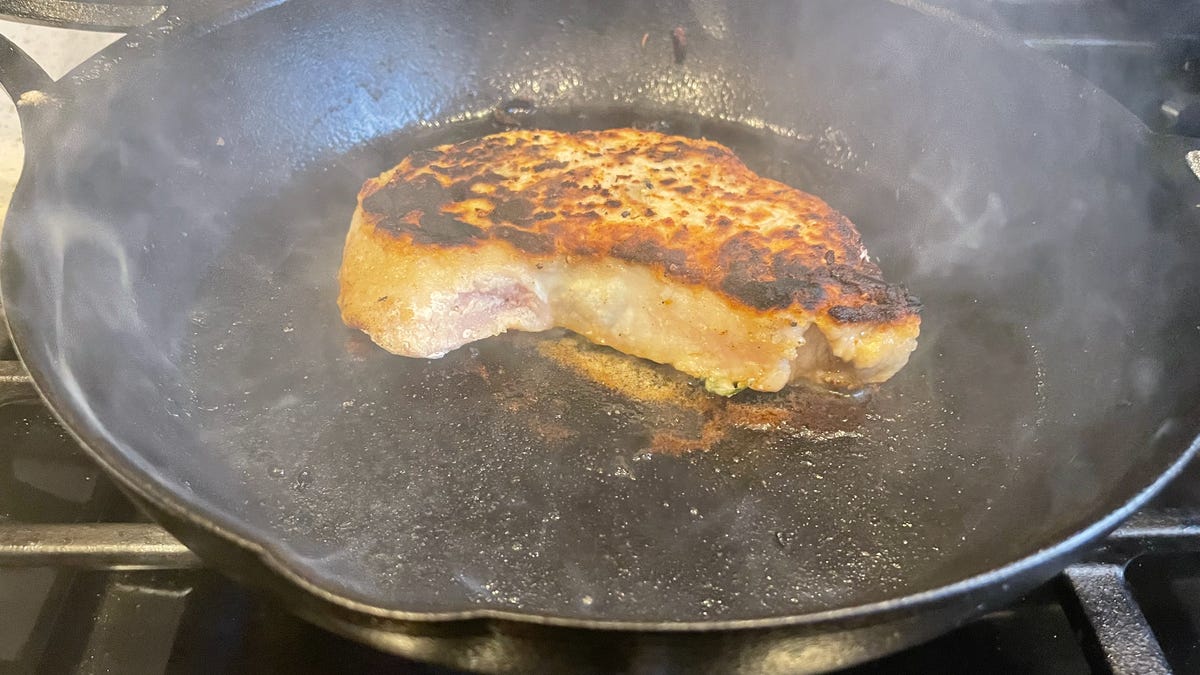
Cast iron takes a little more care to clean than some other materials, but it's definitely worth it.
If you've seared a holiday roast or batch of breakfast hash in a cast-iron pan, you're doing it right. The price for your perfectly caramelized crust might be a scorched skillet, but it can be cleaned easily and safely using something you already have in the pantry.Cleaning cast-iron cookware requires a different technique than washing nonstick or stainless steel pans. Cast iron is tough and able to withstand scorching heat, the trash of metal utensils and years of banging around an oven range or grill top, but this rugged cookware material has a sensitive side. Along with seasoning your cast-iron pan, cleaning it properly will ensure it has a long and productive life.
Whatever you do, resist the urge to soak your dirty cast iron or run it through the dishwasher. For really stuck-on bits, a simple pantry staple will have your skillet looking better than new.
Give up? It's salt.
Should you put cast-iron cookware in the dishwasher?
Wondering if cast iron is dishwasher-safe? The answer is complicated, but mostly it's not. While a spin through the dishwasher won't completely ruin the pan or render it useless, it will strip that important layer of seasoning and nonstick patina from the surface that you're working to build over time. In short: It won't do the pan any favors.
How to clean your cast-iron skillet like a pro
It doesn't take more than a few minutes to clean a cast-iron pan. You also don't need to give your pan a full, deep clean after every use. If you've only fried an egg or reheated some chick breast, for instance, a rag soaked in warm water is likely all you'll need to wipe it clean.
But if you've just seared something with excess grease or there are stuck-on bits of food hanging out, follow these simple steps and your cast iron will stay clean and continue to hold that beautifully seasoned, nonstick surface.
Clean your cast-iron skillet while it's still warm
I know -- that sizzling pork chop is out of the pan and ready to eat and the last thing you want to do is clean. But, trust me, acting fast will make the job easier. Add warm water to the skillet a few minutes after removing it from the heat while it's still warm -- but not scorching hot or you might warp the metal. That quick simmer will go a long way in degunking the pan.
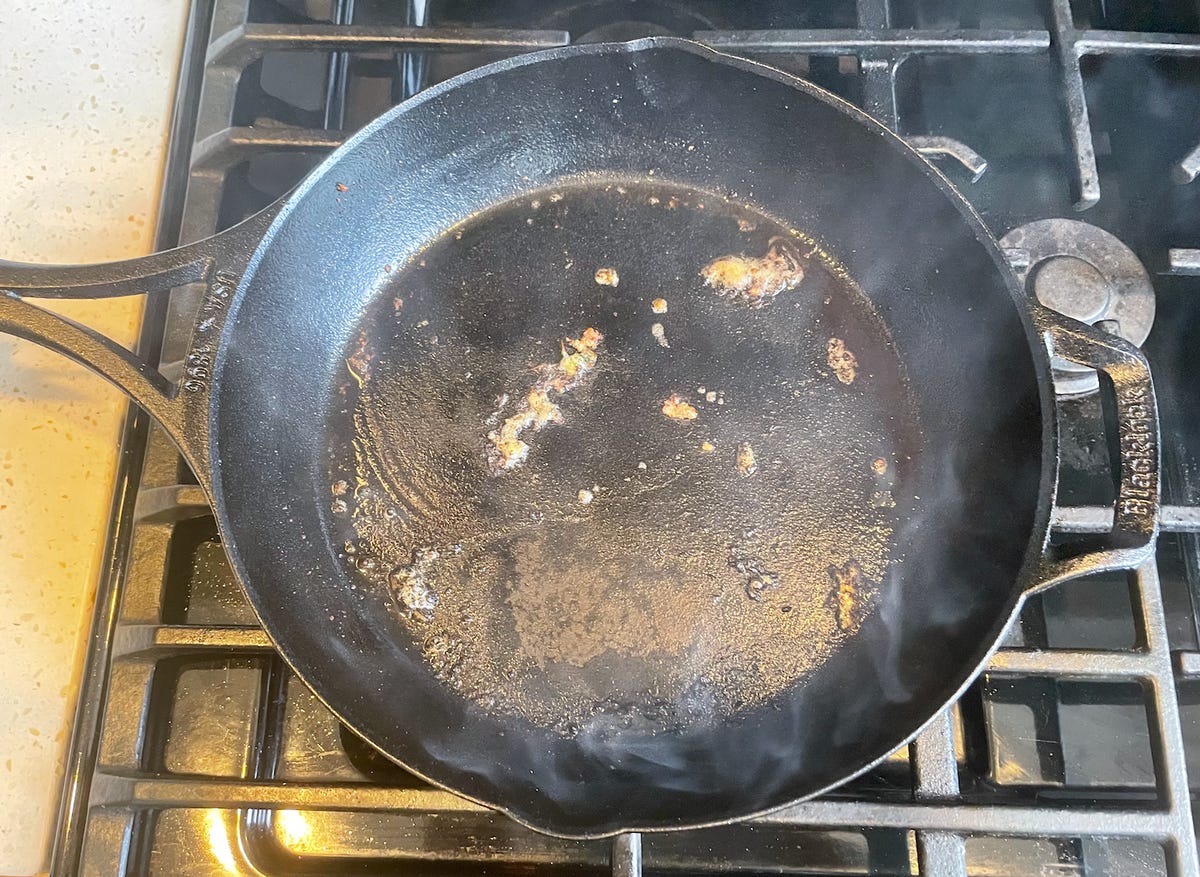
Clean your cast iron while it's still warm.
Scrape with a wooden spoon or soft bristle brush
With the hot water having loosened food from the pan's surface, it's time to use a wooden spoon or soft brush to remove whatever's left.
I like this $11 Oxo cast-iron brush for cast iron. It works great on a classic flat skillet but has separated tufts of bristles so it'll work well on cast-iron grill pans or grates. If you prefer something more natural, a palm scrub brush like these will work, but they might not last as long. You can always grab a standard soft sponge with a scrubby side but just know it'll probably be the final act for that sponge.
Avoid using metal scrubbers that will damage the cast-iron surface. And beware of rubber and plastic spatulas, especially cheap ones, as they may melt against the hot metal.
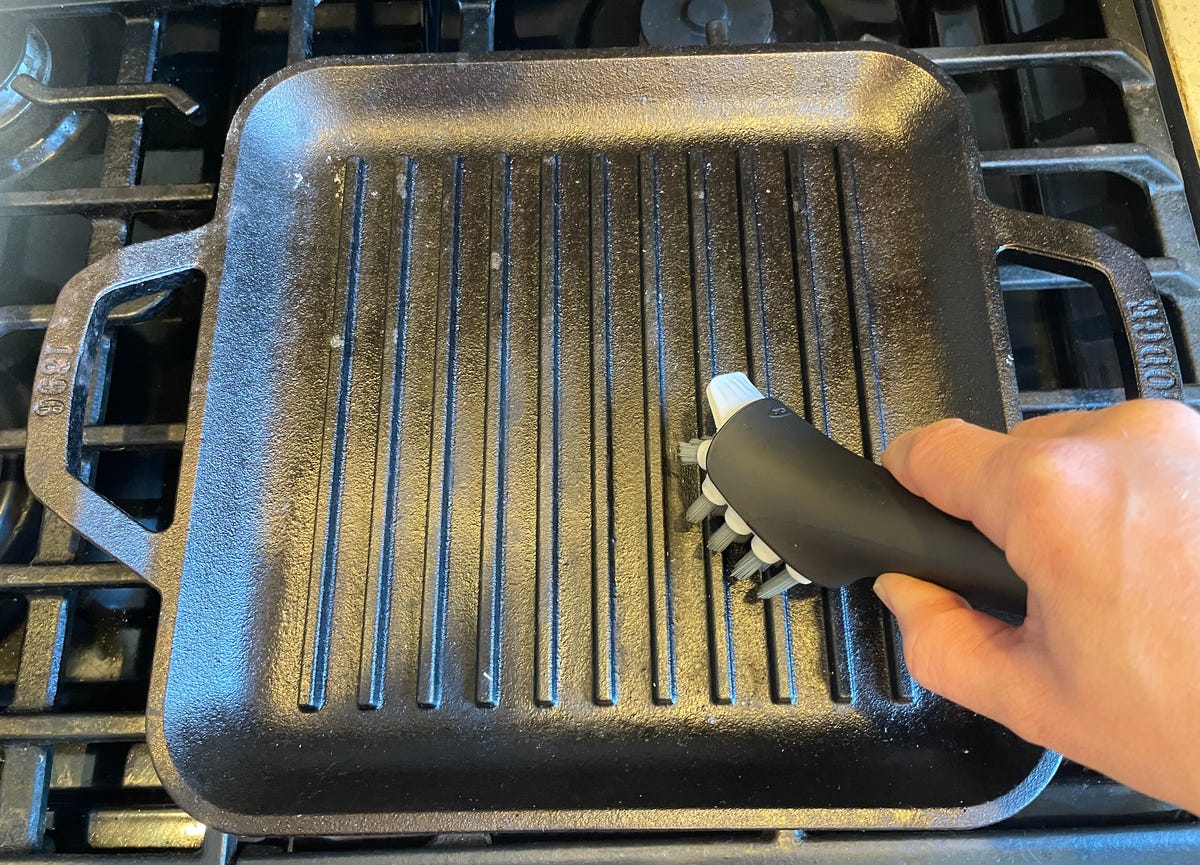
This $11 Oxo brush is tough and especially good for cleaning between the grates of cast-iron grill pans.
From a glance at your skillet, you should be able to tell what kind of cleaning task you have on your hands. After most uses, a dousing of warm water should do the trick. But if things are extra sticky, sprinkle the cast iron with a bit of kosher salt (without water) and scrape it gently with a flat-ended wooden spoon or spatula. Dump the salt and add some water to get things moving.
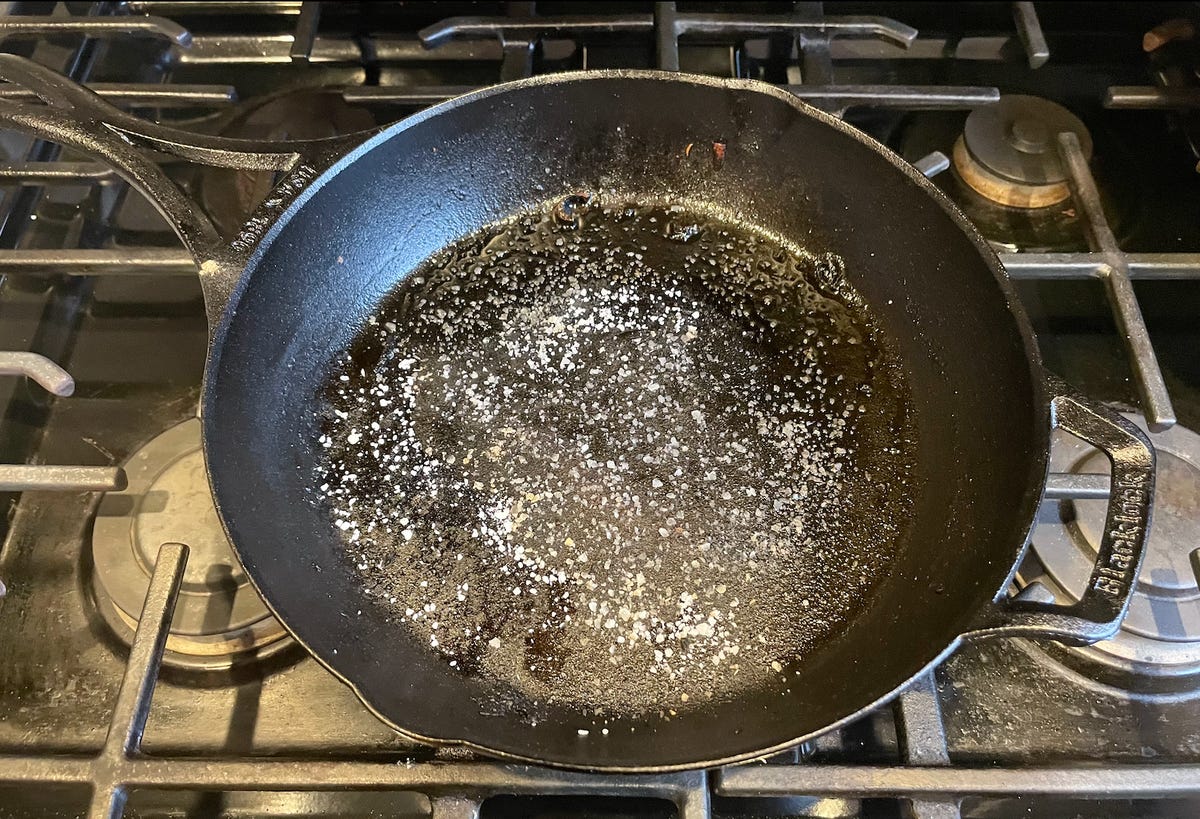
A bit of kosher salt goes a long way in lifting stubborn bits of food.
If you need to scrub harder than you can with a wooden spoon or rag, use a cast-iron safe brush like the ones mentioned above.
Dry your cast iron immediately
Rusting is the most common problem folks face with cast iron, but it's also easily avoided. It's important to dry your cast iron immediately and thoroughly. The best way is to use heat from the stovetop or oven, which will dry your skillet from the inside out, but you can also use a dry rag.
To dry a pan on the stove, just put it over low heat for a few minutes. You'll see it release some steam and possibly some smoke too. When that starts to slow, your skillet is dry. Use medium heat to dry the pan in the oven if it's still on. About 5 minutes at 325 F should be plenty.
Give it a quick reseasoning, why don't ya?
After it's dry and while it's still hot, you can (and should) feel free to season it more with a cast-iron seasoning wax (I like Made In's mix of beeswax, canola and flaxseed oil) or some other high-heat cooking oil. For more on that, check out this CNET guide to perfectly seasoning your cast-iron skillet.
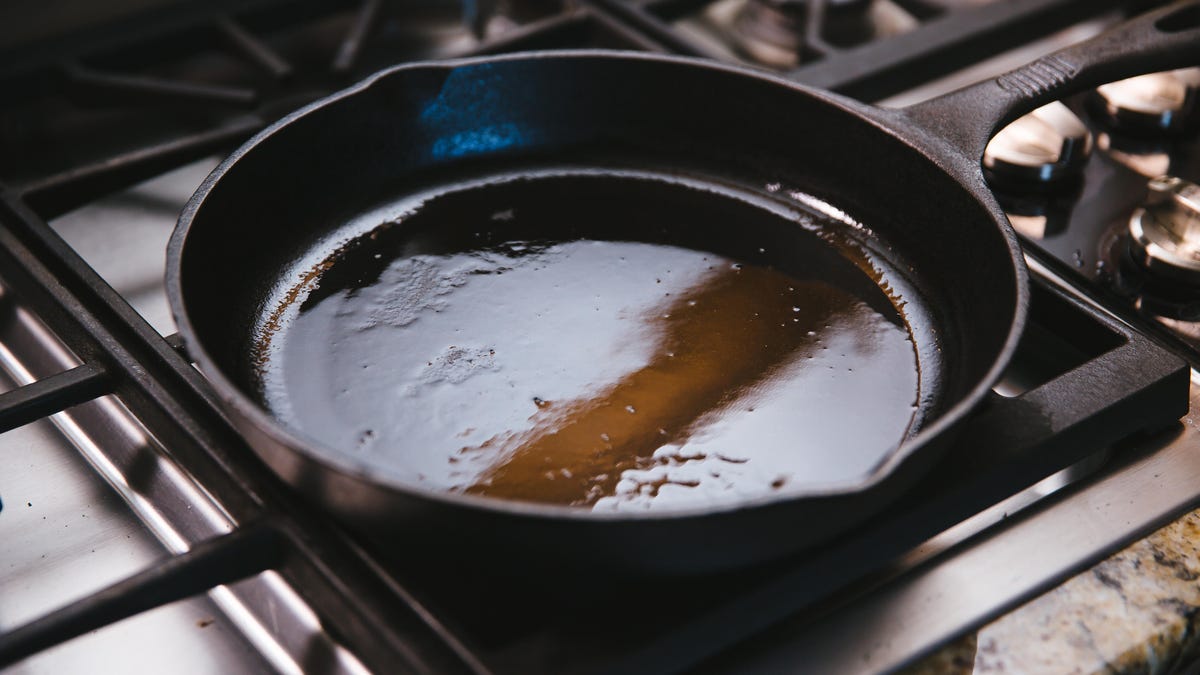
A quick seasoning after every few uses will keep your cast-iron skillet in great form
Can you use dish soap on cast iron?
The No. 1 cast-iron cookware cleaning question is whether or not you can use soap to clean a skillet or grill pan. The answer is yes, but you should try not to. A little bit of soap -- I mean a real small dab -- won't ruin your cast iron, but certain harsh soaps will erode the nonstick patina and could also affect the flavor your cast iron has developed.
Hot Sale Round Shape Cast Iron Enamel Casserole
Kitchen and Household Guides
Gas Stove Are Here to Stay, but Are They Safe? Here's What You Need to Know
Roughly 97% of existing stoves meet the new energy-efficiency standards, but the new measure does little to address the concerns over health risks posed by gas stoves.
The new measures, which go into effect in 2028, address the environmental impact of natural gas stove use (although it's unclear how much of an impact they will have) but do nothing to address the growing concerns over potential health risks associated with the popular large appliances.
Are natural gas stoves safe? What can be done to protect yourself from harmful toxins caused by a leaky gas stove? We'll try to answer both questions to help you mitigate risk for your home and family.
Are gas stoves safe?
While more research is needed, two recent studies have shown that natural gas stoves leak more than was previously known and that leaked gas poses a bigger long-term health threat, particularly to the respiratory health of children (more on that below).
The conversation around gas stove safety reached a fever pitch in January 2023 when Richard Trumka, an official with the US Consumer Product Safety Commission, hinted in an interview with Bloomberg that natural gas stoves could be banned if found to be dangerous.
Trumka has since walked back the comments following a maelstrom of backlash. While the CPSC has not made any formal statements about natural gas stoves being unsafe, there is mounting evidence to the contrary.
As many as 40% of stoves in the US run on natural gas. In its unburned state, natural gas contains harmful air toxins, including benzene, a chemical linked to cancer, and methane, which is harmful to the environment. In theory, natural gas' harmful toxins are eliminated during combustion, but last year's Harvard study proved stoves often leak the toxic unburned gas when not in use. The study also found that the odorants added to natural gas to help people detect leaks were done inconsistently, making it harder to catch a gas leak using your nose.
Another study from December 2022 showed that US homes with natural gas stoves had 13% more instances of childhood asthma. The number was even higher in certain states, including Illinois, New York and California.
A leaky gas stove is often more dangerous in winter
The dangers of gas stoves are heightened during colder months when most of us keep windows closed, making kitchens more difficult to ventilate.
There are simple ways to prevent and detect dangerous air quality conditions and keep yourself safe. Adding a powerful fan, air purifier or both to the kitchen and running them when the stove is on will lower the chances of air quality becoming dangerously poor.
How to protect yourself from natural gas
1. Keep your kitchen ventilated and always run the exhaust fan
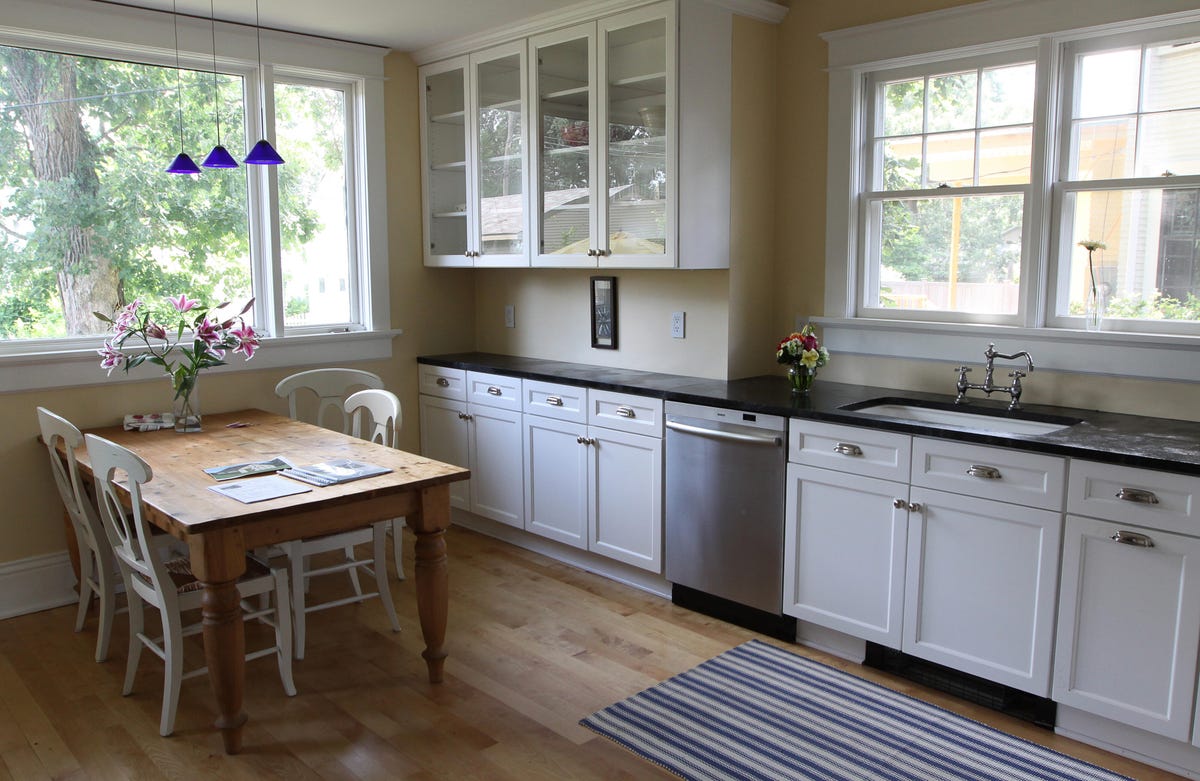
Keeping kitchen windows cracked while cooking is the best defense against harmful toxins and poor air quality.
Keeping your kitchen well-ventilated, especially while cooking with gas, is one of the best defenses against gas leaks, airborne chemicals and toxins. Most kitchens have windows; if weather permits, always keep one open or cracked while cooking.
During these colder months when cracking a window isn't always a viable option, you should consider adding a powerful fan to the kitchen that will help disperse concentrated air that may be harmful.
You should also run the exhaust fan above your range whenever the oven burner or stove is on and keep it running for 20 minutes or so even after you're finished since nasty stuff such as benzene and carbon monoxide may still be lingering in the air.
2. Monitor your kitchen's air quality
Airthings View Plus will monitor your air quality around the clock and alert you if things become dangerous.
Arguably, even more important than kitchen ventilation is keeping tabs on your air quality, and several devices are designed to do just that. Adding a carbon monoxide detector is a good start, but most are limited in the toxins they detect. More advanced air quality monitors such as Airthings View Plus and Nest Protect will register other volatile organic compounds (the bad stuff) and sync with an app to alert you directly via your mobile device when air quality becomes dangerous.
As a bonus, monitors like Airthings detect radon, an airborne carcinogen that occurs naturally as well as other harmful VOCs emitted from plastic wrapping materials, packaging and elsewhere.
3. Don't let the burner run without ignition
This one may seem obvious, but letting the gas run before lighting more than a second or two can emit harmful toxins into your kitchen. If your stove burners aren't igniting right away, you may want to have the stove inspected, repaired or replaced. Double check that all burners are switched off when you've finished cooking.
4. Adding an air purifier can help, but it's not a fix-all
HEPA air purifiers will reduce volatile organic compounds but not eliminate them. They should be used in concert with other defenses against poor kitchen air quality.
HEPA air purifiers help to clean dirty air, and adding one can lower the risk of airborne toxins in the kitchen. There are several toxins in natural gas, including benzene and carbon monoxide, that air purifiers won't remove. Plopping one by the stove is by no means a panacea for poor kitchen air quality. HEPA air purifiers may reduce these harmful volatile organic compounds but they won't eliminate them. These products should be used in concert with other defenses and safeguards.
5. Have your gas stove checked for leaks
If you're concerned about your stove leaking gas, call the gas company and they will likely send someone to check free of charge.
Last year's Harvard study shows that gas stoves leak far more when not in use than previously thought. Because this gas is unburned, it's particularly toxic if inhaled. If you're worried about how much gas is leaking from your stove, you can have it tested by a service person from your gas company or hire a professional.
This is particularly important if you ever smell gas in the kitchen. If you do, you can bet there is probably a gas leak, and you should vacate the home until the problem is identified. If you want to test for gas leaks yourself, you can buy a detector for about $24 on Amazon.
6. Switch to propane gas or an electric stove
Induction stovetops pose far lower risks than their natural gas counterparts.
This is the most surefire fix but also the most inconvenient and expensive solution. Switching to an electric stove or non-toxic propane fuel will mitigate the risks associated with natural gas. Even cooking with an electric stove can negatively affect air quality since burnt food and oils can release toxins into the air. It's a much lower risk than natural gas but is still reason enough to keep your kitchen ventilated and regularly test for air quality.
Check out more CNET Home Tips including how to slash your monthly internet bill and the three places to never put a home security camera.
-
Why Every Home Cook Needs a Cast Iron Meat PressNewsNov.12,2024
-
Unlock Perfectly Seared Steaks with the Cast Iron Meat PressNewsNov.12,2024
-
Master the Art of Cooking Thick Cuts of Meat with a Cast Iron Meat PressNewsNov.12,2024
-
How to Care for Your Cast Iron Meat Press: Tips for Longevity and PerformanceNewsNov.12,2024
-
How a Cast Iron Meat Press Enhances the Flavor and Texture of Your BurgersNewsNov.12,2024
-
Roasting Pan for Perfect MealsNewsNov.04,2024
-
Perfect Skillet for SaleNewsNov.04,2024

